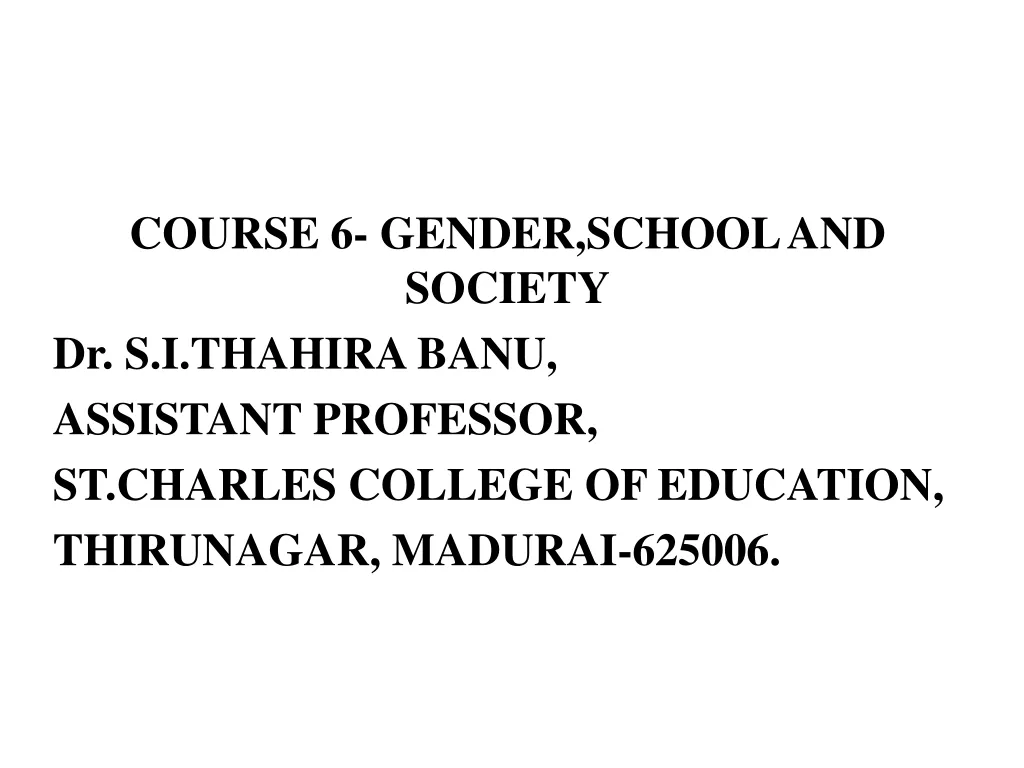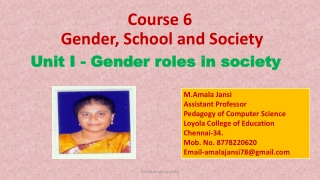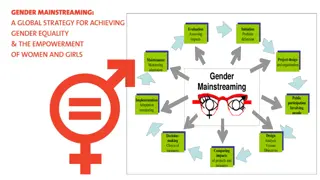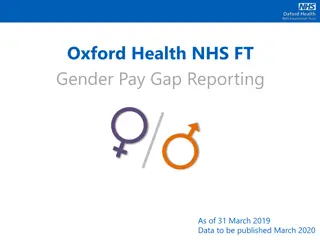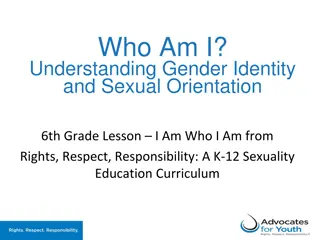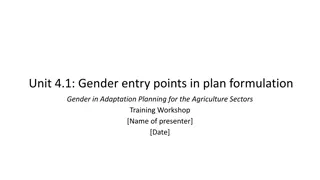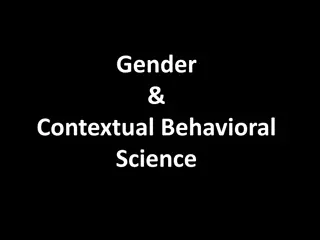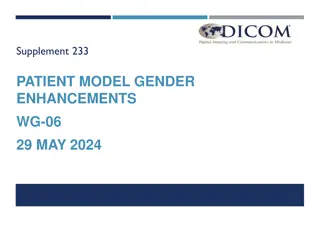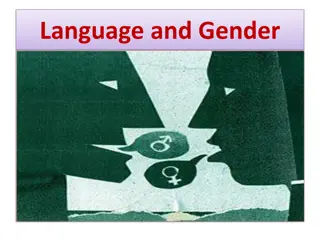
Exploring Language and Gender in Society
Dive into the intricate relationship between language and gender through an insightful group presentation discussing the definitions, societal perceptions, and gendered practices. Discover how language shapes gender roles and influences social constructs.
Download Presentation

Please find below an Image/Link to download the presentation.
The content on the website is provided AS IS for your information and personal use only. It may not be sold, licensed, or shared on other websites without obtaining consent from the author. If you encounter any issues during the download, it is possible that the publisher has removed the file from their server.
You are allowed to download the files provided on this website for personal or commercial use, subject to the condition that they are used lawfully. All files are the property of their respective owners.
The content on the website is provided AS IS for your information and personal use only. It may not be sold, licensed, or shared on other websites without obtaining consent from the author.
E N D
Presentation Transcript
Language and Gender Language and Gender 5010HUM CW1 Group Presentation By Lance Honeghan Diya Chopra Karan Sahota Olivia Hughes Nidhi Shukla
Introduction: Language and Gender is an integrative field that researches writing and speech in terms of sexuality, gender, gender relations and gendered practices. Many critics argue that men and women speak differently. In 1972, linguist Robin Lakoff published an article titled Language and women s place in this Lakoff argued that women have different ways of speaking to men. This difference reflects their positions within society. Gender branches into three important sections, the media, workplace and education. These sections are important as they give a better understanding of ongoing social experiences. Nidhi Shukla
Definitions of Gender and Sex Definitions of Gender and Sex Gender is difficult to define as traditionally; it refers to the role of a male or female in society. However, with society changing and becoming increasingly diverse the meaning of gender has also shifted to become more inclusive. Gender refers to socially constructed components of both men and women. For example, relationships of men and women, roles and norms. Gender roles are not set in stone and can be changed from society to society. Sex generally refers to the biological difference between females and males. Often someone's biological sex is not what someone identifies themselves as. For example, people refer to themselves as Transgender, gender- nonbinary, bigender etc.
Language and Gender Language and Gender Penelope Eckert and Sally McConnell Penelope Eckert and Sally McConnell- -Ginet Chapter 1 Chapter 1 Ginet
Chapter Summary: Eckert and McConnell-Ginet s Language and Gender deconstructs gender as a concept, covering several assumptions and unexplained standards that society treats as fact. This chapter takes a step back and examine[s] gender from a new perspective ,(Eckert &McConnell-Ginet 2003: 9) later outlining that the work takes a feminist reading. The chapter mainly focuses on the differentiation between sex and gender, with the predominant message being that gender is nothing but a learned performance that comes with constraints, constantly developing from infancy to adulthood. Eckert and McConnell-Ginet explore gender as a social construct in a variety of situations, including film, literature, workplaces and within families. Olivia Hughes
The chapter explores further the notion of gender being nothing but a social concept believing that gender is the very process of creating a dichotomy by effacing similarity and elaborating on difference (Eckert & McConnell-Ginet 2003: 13) The research recognizes biological constraints, however, treats the elaboration and magnification of differences as entirely social. To support this deconstruction, the chapter looks closely at several arguments that both, support and disagree with gender as a construct. For example, it explores the rise of particular hormone levels in other species that change according to social position, as well as specific examples in film, fashion and colour association. To explain this concept, Eckert and McConnell-Ginet suggest that the eagerness of society to explain differences between the sexes means that the differences and similarities that blur the edges of these categories (Eckert & McConnell-Ginet 2003: 13) often go ignored. Overall, the chapter consistently argues that gender is a construct formed by society. It is collaborative and has to be taught as well as learned. Olivia Hughes
Gender is embedded so thoroughly in our institutions, our actions, our beliefs, and our desires, that it appears to us to be completely natural (Eckert and McConnell-Ginet 2003: 9). Penelope Eckert and Sally McConnell-Ginet focuses on how gender is constructed, from birth up until you become an adult. Within this chapter, gender is referred to something that we are not born with or have but something we do (Eckert and McConnell-Ginet 2003: 9). In other words, gender is something that is constructed by our surroundings which society conforms to as it is seen to be the norm . Examples of how gender is constructed by our surroundings is through the way we dress. Stereotypically, boys tend to wear colours like blue and girls tend to wear colours like pink when they are a child. This then categories what each gender should consist of, creating a constant pattern that occurs all the time which becomes the norm. The next thing that is discussed in this chapter is sex. Karan Sahota
According to Eckert and McConnell-Ginet (2003: 10), we think of sex as biological and gender as social, however this distinction is not clear . Our own cultural beliefs acts as the foundation that helps us to distinguish what makes someone male and what makes someone female and how both sexes use language. According to Anne Fausto-Sterling (2000), labelling someone a man or a woman is a social decision. We may use scientific knowledge to help us make the decision, but only our beliefs about gender - not science - can define our sex (Eckert and McConnell-Ginet 2000: 10). We never seem to question why we categorise people by the way they behave, dress or their beliefs and ideas, it is something we do without realising we do it. This is due to society s ideology on gender. An example where we do not realise what language we use is when a couple gets married. They are referred to as Mr and Mrs Jones not Mrs and Mr Jones (Eckert and McConnell-Ginet 2003: 34). Another example is when men raise their voice compared to when women raise their voice. Men would be perceived as strong minded for standing up for what they believe in whereas women would be perceived as crazy who is overacting. This shows that not only are males seen to be more powerful than women in society but they are also more powerful in terms of language. Karan Sahota
Condry and Condry (1976) found that adults watching a film of a crying infant were more likely to hear the cry as angry if they believed the infant was a boy, and fearful if they believed the infant was a girl (Eckert and McConnell 2003: 17). This is another example how adults views of babies are influenced by their beliefs about sex. It is a reoccurring thing that happens in everyday life, whether it consciously or subconsciously. There are many questions and opinions about what gender and sex actually means and how it connects with language. However, a common factor that has occurred throughout this chapter that may help us answer those questions is how we interpret gender and sex based on our own ideas. Once these ideas and beliefs are set in stone, the way men and females use language stem from these ideas and beliefs. Karan Sahota
Gender and Language Theory and Gender and Language Theory and Practice Practice Lia Lia Litosseliti Litosseliti Chapter 2 Chapter 2
Deficit Model Deficit Model Suggests that female language is inferior to male language (Litosseliti 2014: 28) Jespersen s claims that men were greater orators put the study of women s language on the map (Litosseliti 2014: 28). Lakoff s Language and Women s Place suggests that women s language is deficient and suggests insecurity and uncertainty (Litosseliti 2014: 28). Lakoff uses men s dominance to explain gender differences and why, therefore, women s language is deficient (Litosseliti 2014: 28-29) Lakoff's work has been widely criticized for perpetuating stereotypes, ignoring contextual and social influences and making claims without empirical evidence like Jespersen (Litosseliti 2014: 28-30) However, it must be noted that Lakoff was criticizing a particular idea of femininity rather than an empirical description of it. (Litosseliti 2014: 29) Lakoff has made an important contribution to study of women s language (Litosseliti 2014: 30) Lance Honeghan
Dominance Model Dominance Model Language differences due to women being dominated by men in interaction (Litosseliti 2014: 32) Dissimilarly to Lakoff, Fishman found that women s language was interactional and facilitative rather than showing signs of insecurity or uncertainty (Litosseliti 2014: 33) Language differences caused by inferior social position rather than inability (Litosseliti 2014: 32) Studies suggest that a higher usage of interruptions highlights men s attempts to control and maintain not only the macro-institutions in society, but also the micro- level of conversation (Litosseliti 2014: 34). However, other studies found no gender differences in the frequency of interruptions. This may be due to methodological issues, such as the difficulty of defining interruptions and contextual influence (Litosseliti 2014: 34) Criticized for over-emphasizing subordination of women and making broad cultural assumptions about gender (Litosseliti 2014: 37) More useful than deficit model as it challenges the male right to control language, places greater emphasis on sociocultural factors, and uses empirical evidence to support claims (Litosseliti 2014: 37) Lance Honeghan
Difference Model Difference Model Differences are due to the fact that boys and girls are socialized differently and belong to different sub- cultures (Litosseliti 2014: 37) Adults talk and respond differently to boys and girls causing them to adopt different linguistic choices and interaction styles (Litosseliti 2014: 37) The consequences of not conforming reinforce differences in language (Litosseliti 2014: 37) Deborah Tannen s You Just Don t Understand- Men and Women in Conversation encourages men and women to understand each other and not blame one another for miscommunication in interaction (Litosseliti 2014: 38) Tannen highlights the importance of re-evaluating women s language. For instance, studies found that gossip talk had positive functions and is integral to the construction of the self (Litosseliti 2014: 38-39) This model attempts to positively value differences unlike other models (Litosseliti 2014: 39) However, the model lacks a complex conceptualization of gender and cannot make claims that boys and girls are part of different sub-cultures because this ignores other factors such as race, age and class (Litosseliti 2014: 39) Future models should Take into consideration other influences such as race, class, age and context on language use (Litosseliti 2014: 40-44) Consider the effects of gender on language use, without attempting to suggest that gender determines language use (Litosseliti 2014: 40-44) Lance Honeghan
Variation within language used by Variation within language used by men and women men and women The Social Status Explanation suggests that some linguistics consider women to be more status conscious than men (Holmes 2017: 175) and ultimately use more standard forms of English compared to men. This directly correlates to women having a tendency to be over-polite (Litosseliti 2014:28), in social situations, where men can afford to adopt a more direct approach, resulting in women to be viewed as a more subordinate group within society. The interpretation suggests women resort to using standard forms of English as a way of seeking approval (Litosseliti 2014:29) and ultimately looking after their need to be valued within society, since a rising intonation would be disadvantaging their power positions (Litosseliti 2014:29). This analysis links to our understanding of social class and how members of a higher social class are more likely to use standard forms of English in attempts to affirm their superiority compared to members of a lower socio-economic class, who adopt the use of more vernacular forms. Diya Chopra
Language used to control and dominate Language used to control and dominate According to the Dominance Model the differences between men and women s language is caused by women, being dominated in interaction , particularly through the discourse feature of interruption. According to Zimmerman and West s 1975 Study, 96% of interruptions were by males to females , signifying gender being parallel to discourse and that men use language as a platform on which they inexplicitly assert their dominance over women. Similarly women tend to use more tag questions and hedges within interactions with male participants. Pamela Fishman considered these types of discourse features to be a sign of women s insecurities and hesitancy implying their submissive position within a conversation compared to men. The connotations of these discourse features highlight men s ability to use language to amplify their superiority in society compared to women, the subordinate group. Diya Chopra
Gender impacting the way discourse is Gender impacting the way discourse is perceived based on its users perceived based on its users There are different factors that impact the way discourse is perceived based on its users. Lakoff s commentary about women in the 1970 s being faced with a double-bind situation is a prime example of language controversy. When men adopt the use of direct language, the individual is considered to be strong and in a position suited to authority however, if women adopt a direct language then they are accused of being unfeminine and ultimately if they talk like a lady, they risk being ignored (Litosseliti 2014:31). Since men using direct language is perceived more positively compared to women, we can assume there is a difference in the way people are treated in the workplace based on their gender. This also links to our knowledge on pitch and how women in politics are more likely to thrive by adopting a lower pitch, to sound similar to a male s naturally lower voice. Margret Thatcher (UK Prime Minister 1979-90) purposely took lessons to lower her voice. As a female politician during the late 70 s into the 90 s, lower her voice was an attempt to gain acceptance in a male dominated sphere. (Holmes 2017: 184) Diya Chopra
Conclusion: Conclusion: In conclusion, there are obvious differences in how men and women speak, their styles and their conversations. As well as this men and women just have different preferences they use when speaking. In addition, the way men speak, implies they are the more dominant out of the two sexes. This is shown through things like status and connection as men speak for status and power and women speak for solidarity and support. In summary, this could be due to the evolution and the different tasks that were assigned to males and females have created the foundation for how they speak today. Nidhi Shukla
References Eckert, P. & McConnell-Ginet, S. (2003) Language and Gender [online] Cambridge University Press. Available from < https://ebookcentral.proquest.com/lib/coventry/reader.action?docID=221102 > [30th October 2019] Goodreads (2019) Language and Gender [online] available from <https://www.goodreads.com/book/show/330623.Language_and_Gender > [30th October 2019] Holmes, J and Wilson, N. (2017) An Introduction to Sociolinguistics. Milton: Routledge Litosseliti, L. (2006) Gender and Language: Theory and Practice. London: Oxford University Press Robin Lakoff (1973) Language and Women's Place (Online) Cambridge University Press - https://www.cambridge.org/core/journals/language-in-society/article/language-and-womans- place/F66DB3D1BB878CDD68B9A79A25B67DE6

